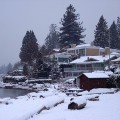What is North?
There are all kinds of North. There is [the] Little North located west of Montreal. There is the Middle North of the boreal forest. And also the Great North of the arctic islands, kingdom of the polar bear, as its name implies. And finally, there is the North of the North, that which mates with the four winds to attain the unattainable, that which rages and lays down the law on that final refuge, the igloo." (Adapted from filmmaker Pierre Perrault's Le mal du Nord.) As northerners, Canadians have a lot of different definitions of what constitutes 'the North.' For southern Ontarians fleeing the city on summer weekends, such locales as Muskoka, Lake Huron or the Kawartha Lakes are 'up north,' despite being perhaps only a few hundred kilometres away. Many Torontonians consider Moosonee, 1,000 kilometres north of Toronto on the shores of James Bay, 'up north.' Yet Moosonee is at about the same latitude as Calgary, which Edmontonians often call 'the deep south.' Of course, Canadians also think of the North as Canada's Arctic, that vast triangular land mass stretching from the tip of Ellesmere Island in the Arctic Cordillera ecozone, across the broad expanse of the northern Arctic, and into the southern Arctic just above the tree line. This defines the Canadian North as more than four times the size of France.
The Canadian Encyclopedia refers to the North as "the immense hinterland of Canada that lies beyond the narrow strip of the country in which most Canadians live and work, but generally refers to the Northwest Territories, the Yukon and Nunavut." In other words, the North is anything north of the 60th parallel-the southern boundary of the three territories.
The Canada Customs and Revenue Agency's definition of the North-used to determine tax benefits for residents of isolated communities-is based on population, distance to an urban centre, climate and vegetation. In this respect, the North encompasses all of the Yukon, the Northwest Territories, Nunavut and Labrador, as well as the northern parts of British Columbia, Alberta, Saskatchewan, Manitoba, Ontario and Quebec.
In January 2000, Statistics Canada tossed another definition of the North into the mix. Statistics Canada analysts created transition zones to reflect the gradual changes that occur between south and north.
The new boundary was drawn by averaging north-south lines that had been previously used to determine income tax relief zones, all-season roads, temperatures, southern limits to the boreal forest and the cost of goods and services. Analysts took into account that traditional descriptions of the North have ignored more southerly regions of the country-such as the northern regions of most provinces and Labrador-even though they share a climate, physical attributes and settlement patterns with areas farther north.
Statistics Canada's redefinition of the North produced a boundary that cuts through the middle of the country, bordered on either side by gradual transition zones from north to south. The north transition line juts south to nearly the middle of Manitoba and Ontario, while the south transition line cuts as far south as Calgary, Lake Winnipeg, Thunder Bay and the Gaspe Peninsula.
Drawing a single boundary to divide north from south can blur the individual character of the North. Extending the boundaries to include areas of transition can promote understanding of the needs and aspirations of Canada's immense northern regions.

